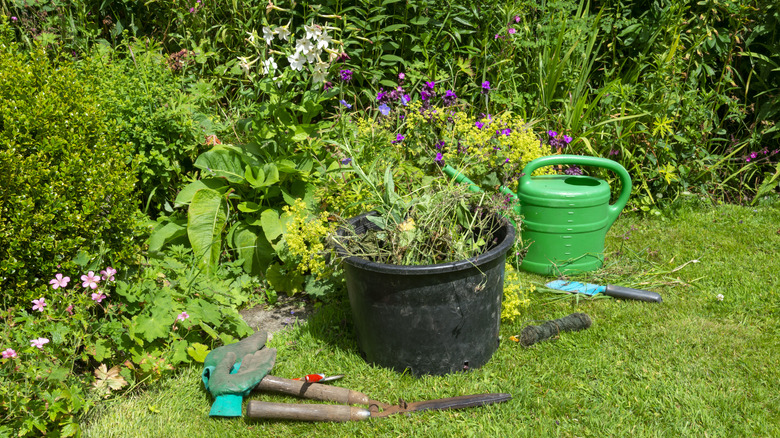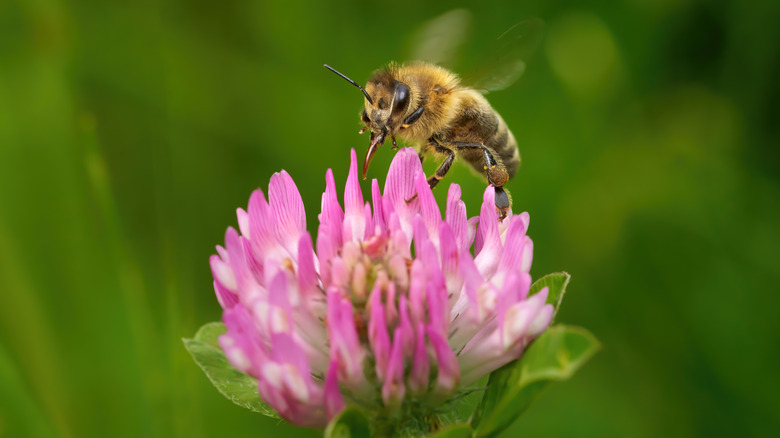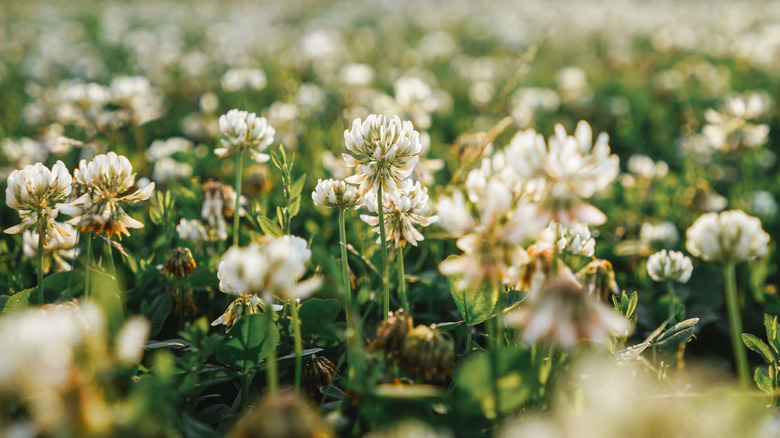Why You Actually Want This Weed To Grow On Your Lawn
We may receive a commission on purchases made from links.
Weeds are widely considered problematic, so much so that homeowners often spend good money to keep their lawns clear of them. However, many weeds bloom flowers that are important in nature, supporting birds, pollinating insects, and other animals. That's why even some weeds are beneficial to grow in your yard, such as clover.
The clover plant is a legume and hasn't always been considered a weed. Prior to the 1950s, it was even included in seed mixes. It was only labeled as a weed because it (along with everything else but grass) died when newly developed herbicides were applied. Unfortunately, clover feeds the soil with nitrogen that dirt bacteria use to produce ammonium, which grass absorbs to become greener and stronger all year. Without it, grass needs synthetic fertilizer to be healthy. Clover also increases the nutrients available in soil so that crops can grow better.
Along with bringing natural nutrients for grass and crops, clover is food for some animals, such as livestock, rabbits, and white-tailed deer. That's because the plant is full of calcium, phosphorus, and protein. Additionally, clover can grow in most types of soil, is tolerant to hot and cold temperatures, and requires less watering and mowing than grass. It can even withstand pet urine, unlike grass which becomes discolored and unsightly.
Disadvantages to know about a clover lawn
Before you decide to add clover to your lawn for the benefits, it's only fair to consider the disadvantages as well. The biggest drawback is that its flowers attract stinging insects. Sure, the flowers are beneficial for bees, butterflies, and similar insects in regard to pollination, and they make your yard a friendly space for wildlife, like birds and rabbits. But if small children or people with allergies to stinging insects spend a lot of time on your lawn, you might want to avoid attracting them to your yard with the addition of clover.
Another primary drawback (but an advantage to some people) is that clover, like other weeds, can spread into areas where you don't want them to grow — without any help from you. This includes cracks in driveways and sidewalks and in gardens and neighbors' yards, so many homeowners associations prohibit them from being planted. One way that clover seeds are spread is by being carried from one place to another by animals, foot traffic, and wind. And, since they are very durable, they can lie dormant for an extended period before germinating. Also, this plant is considered an invasive species that spreads through stolons: above-ground stems that creep along the top of the soil and take root at multiple points.
How to transform your lawn with clover
When you're ready to turn your yard into a clover lawn, there are a few types to choose from: white clover (Trifolium repens) — also known as Dutch clover — red clover (T. pratense), and crimson clover (T. incarnatum). Compared to the white clover, the red variety has pinkish purple petals, elongated leaves, and taller stems but they die faster and may be harder to mow down. Crimson clover grows even taller with more elongated leaves and much redder cone-shaped clusters. Then there are micro clovers, which are simply white clovers with shorter stems, smaller leaves, and are less clump-forming.
If you don't want to choose between these, you can get a variety blend — like the Eertz tri-color blend. How many seeds you need will depend on how big your lawn is. Generally, 2 pounds of seeds will cover 1 acre, but the average lawn only needs about a quarter or half pound. The best time to plant them is in the spring if you live in an area that has cold winters but in the late summer to early fall if your area has mild winters. In either case, after using a rake to dethatch your yard — remove the top layer of organic materials — you can sprinkle the seeds by hand or with a seed spreader.
Finally, lightly cover the seeds with topsoil, but don't add so much that you can't see the grass anymore. For the next couple of weeks, water the area well until seedlings emerge. You can let regular rain take over after that for the most part. When the summer is dry, though, you may need to water the lawn once or twice a week.


